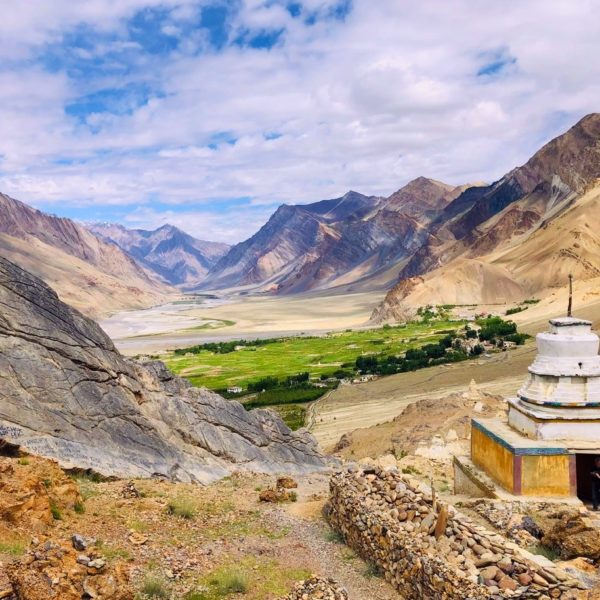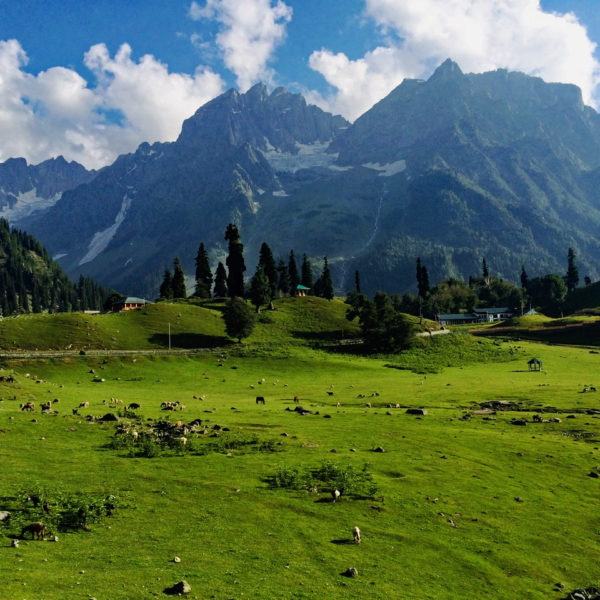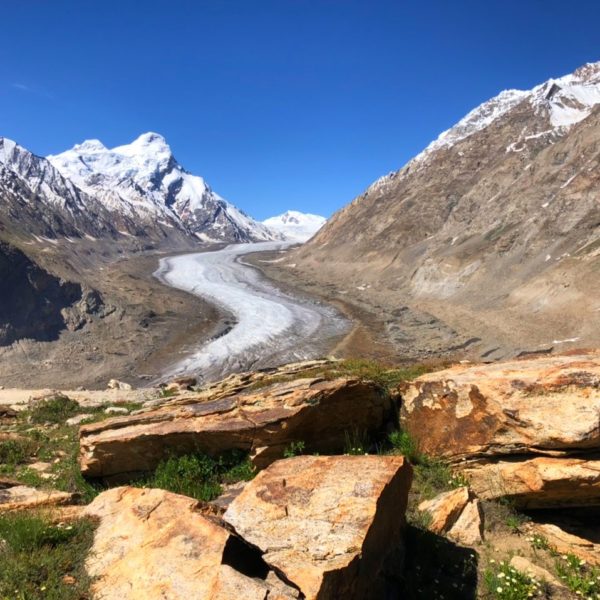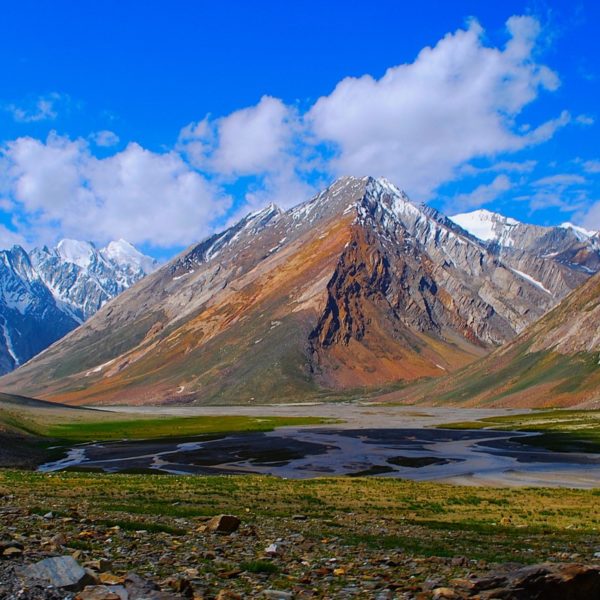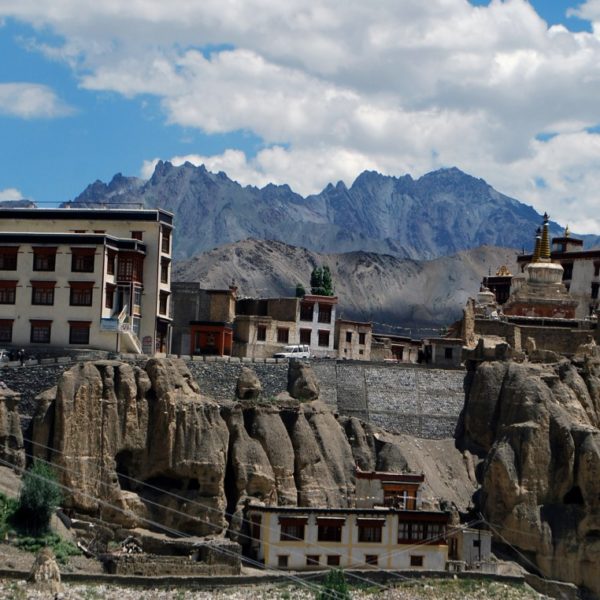Kashmir, Ladakh, Zanskar – Jewel of the Himalayas 15 days
Kashmir is one of the most fascinating regions of the world. Located at the feet of the Himalayas, endowed with true miracles of nature, is a place where religions, traditions and cultures of the East and West and of the North and South met.
The culture, tradition and architecture of Kashmir were shaped for centuries by unending mighty invasions of powerful empires and migrations of followers of major religions. A visit in Kashmir evokes Shangri-La, the land of eternal happiness, where people live in peace and harmony with their neighbours, the nature and gods. Its inhabitants are flush with affluence, peace, health and longevity. A visit in the Zanskar Valley may give us a certain idea about the legendary land. While visiting towns, rural villages and monasteries, it will sometimes be difficult to believe that it still remains one of the most explosive regions of Asia.
itinerary
Meeting with the tour leader at the Delhi domestic airport. Arrival in the summer capital of the Jammu and Kashmir state – Srinagar. Transfer from the airport to the marina and then transfer on shikars to the Victorian house boats on which we will live. In the afternoon, a cruise by shikars on the picturesque Dal Lake, the Kashmir Venice. We will visit floating gardens and wonderful places surrounded by lotus flowers. There will be an opportunity to visit a local shop with papier mâché and pashmina products. Dinner and night rest on a Victorian house boat.
D.
In the morning, after breakfast, a whole-day visit to the Kashmir capital. We will see the superb Mughal gardens – Nishat Bagh and Shalimar Bagh, and also Pari Mahal, which is also a perfect vantage point with views of the town and lake. Visits to the snow-white Hazratbal mosque that contains a Muhammad relic, a 15th-century Jamia Masjid mosque in the old town, and also the oldest historic building of the town – the Shah-i Hamdani sanctuary that is made of papier mâché. To end the day, a visit in the Hindu Shankarachaya temple located on the mountain with a beautiful panoramic view of the lake and town. Sunset on the Dal lake. Dinner and night rest on a Victorian house boat.
B. D.
Early in the morning, if possible, going by shikars to the floating market when local men exchange vegetables that they grow. In the morning, after breakfast, we will set off to Pahalgam. We will visit on the way ruins of 9th century temples devoted, for example, to the Hindi gods Vishnu and Shiva, in the town of Awantipora. A hike to the place called “Kashmir Switzerland” or “mini-Switzerland” – a picturesque Baisaran Valley. Dinner. Night rest at the hotel.
B.D.
Early in the morning, after breakfast, a ride to Gulmarg. If time allows, we will also go to see the ruins of one of the oldest sanctuaries in the Kashmir area, dating back to the 8th century – the Martand Sun Temple devoted to the solar god Surya. A drive to Gulmarg, which is both a summer and winter (ski) resort, and also a place famous for the highest green golf course anywhere in the world. A cable car ride to the peak of Apharwat (4390 m above sea level), where picturesque Himalayan peaks can be seen in sunny weather. Return to Srinagar. Dinner and night rest on a Victorian house boat or at a hotel
B.D.
Early in the morning, after breakfast, we will set off to Sonamarg. En route we will visit ruins of a Wangath Hindu temple complex dating back to the 18th century, devoted to Shiva. Ride on a very scenic road to Sonamarg. Hike to the Thajiwas Glacier. Dinner and night rest at the hotel in Sonamarg.
B.D.
In the morning, after breakfast, we will set off to Kargil. Ride through the Zoji La pass (3530 m above sea level) and the second coldest town on Earth – Drass. When we reach our destination, an optional walk around the town of Kargil located on the river Suri, which will be an opportunity to encounter a real melting pot of cultures. Dinner and night rest at the hotel in Kargil.
B.D.
In the morning, after breakfast, we will set off to Rangdom where we will arrive late in the afternoon. On the way, we will have an opportunity to see breathtaking views of the Kargil area, of the Suri River, mountain peaks and glaciers (including Nun Kun) and picturesque rural villages of Sankoo and Panikar. Dinner, night rest in special tents in a camp located near a tiny Rangdom monastery. Tents in the camp are fitted with beds and simple bathrooms outside.
B.D.
In the morning, after breakfast, a visit in the Rangdom monastery. We will leave towards the Zanskar Valley, to Padum. En route, in addition to magnificent views of the Himalayas and glaciers, we will have to cross the Pensi La pass (4400 m above sea level) which is the gate to the Zanskar Valley. Marmots can be seen there. Arrival in Padum late in the afternoon. Dinner and night rest at a hotel/bed & breakfast in Padum.
B.D.
In the morning, after breakfast, we will set off for a visit in the Zanskar Valley. We will visit the Zangla village located at a level of 3450 m, where we will see the old residence of Zanskar rulers – a scenic high-altitude palace and monastery. There are truly majestic views from the palace windows. Visit at the old Stongdey monastery with a beautiful vantage point for Zanskar. On this day, we will also visit one of the most interesting places in the whole of Zanskar – the inaccessible Zongkhul monastery, isolated in the mountains. Dinner and night rest at a hotel/bed & breakfast in Padum.
B.D.
In the morning, after breakfast, we will return to Kargil. We will have a drive of 240 km. Arrival in Kargil, dinner, night rest at a hotel.
B.D.
In the morning, after breakfast, we will set off towards Leh. En route we will cross the Fotula (4110 m) and Namikala (3700 m) passes and we will visit the Buddhist village of Mulbek where a tiny monastery houses a Buddha statue carved in a rock centuries ago. Then we plan to visit the oldest monastery in Ladakhu – Lamayuru, with origins in the 10th century. From the monastery, there are beautiful views of the nearby area and mountains that resemble a lunar landscape. Dinner and night rest at a hotel/camp in Uleytokpo, located in an apricot grove on the Indus River.
B.D.
In the morning, after breakfast, we will set off from Uleytokpo to Leh. This day, we will see the unique Alchi monastery, known from its Kashmir ornaments in wood, original paintings and magnificent statues, and also the Basgo castle located on rocks and vantage points – with a view of point where the Indus and Zanskar rivers merge. At the end, we will visit the famous white Piece Stupa erected atop the Chanspa hill – Shanti Stupa in the town of Leh. Dinner and night rest at a hotel in Leh.
B.D.
In the morning, after breakfast, we will set off for the Nubra Valley. We will cross one of the highest mountain passes in the world – Khardong La (5359 m above see level). A visit in the 15th century Diskit monastery, famous for its 32-metre Buddha Maitrei statue, and also on the sand dunes of the Hunder area. Dinner and night rest at a hotel/bed & breakfast.
B.D.
In the morning, return to Leh. Visit to the old royal palace in Leh and the best vantage point for the whole town and Himalayas – the highest located Tsemo monastery that overlooks the palace. If there is time, we will go to the Thiksey monastery with a huge Buddha statue. Free time to purchase souvenirs and have a stroll in the town centre. Dinner and night rest at the hotel in Leh
B.D.
In the morning, after breakfast, transfer to the airport and flight to Delhi. Depending on the departure time, transfer to the international airport and flight home.
B.
- DAY 15 Afterwards, an optional visit to Delhi (we may see the old town and the condiment market there and the largest mosque in India – the Great Mosque Jama Masjid, the richly decorated Akshardham shrine and the gurudwara – a Sikh temple). Dinner and night rest at the hotel in Delhi.
- DAY 16 Nest day After breakfast, an optional visit to the nearby Lobe waterfalls. It is an exceptional place where water falls directly into the ocean. Lunch at one of local restaurants whose specialty is fish and seafood. Depending on the departure time, transfer to the international airport and flight home.
Practical information
- the length of the tour : 15 or 17 days in Asia;
- start of the trip: Delhi;
- end of the trip: Delhi;
- the highlights of this expedition It is difficult to list all attractions of this exceptional patch of Asia – the capital of Kashmir Srinagar, the truly scenic Baisaran Valley, the Thaijwas Glacier and the surroundings of the small town of Kargil are only the most important of the multitude of attractions that can be seen during a trip to Kashmir. Another attractive feature of this tour will be the possibility to see the local natural sights and to admire beautiful mountain sceneries. The close encounter with the culture and traditions of Kashmir inhabitants may prove an unforgettable experience.
The tour will be a sightseeing trip with some mountain hikes to one of most interesting areas of Asia from the historical and cultural point of view. Because of the special nature of the visited places and of the expedition features, the travellers should be able to participate in walking tours of towns and historic sites as well as in hikes to vantage points. The travellers should also be prepared for the possible appearance of altitude sickness. Accommodation is planned in hotels and we will use passenger cars and minibuses for transfers. Hikes are planned during the trip but they were not be very long. The itinerary was designed to enable best possible viewing of the places away from mass tourism routes, while meeting basic safety standards and ensuring comfort to the travellers. Bear in mind that Kashmir is mostly inhabited by Buddhism, Hinduism and Islam followers, which means the need to respect cultural differences and adhering to the appropriate dress code.
Depending on the political situation, the length of the tour and the order of visited places may change. In a situation of a serious threat to travellers’ safety, the tour may be cancelled. We will keep you updated as to whether the expedition is possible.
- Your passport must be valid for at least 6 months after the planned end of the tour.
- Before departure, you must obtain a tourist visa for India, which does not apply to holders of passports who can travel to this country without a visa.
- Visa can be obtained online on the official website 30 days before the date of the planned arrival to the territory of India – e-visas via the Internet.
- You should take with you for the tour a photocopy of your passport (the photo page) and an additional ID document.
- Before departure, we recommend a consultation with a family physician and a tropical medicine specialist.
- Vaccination against tetanus, diphtheria, viral hepatitis A and B, typhus and polio is recommended. In the Kashmir territory, the risk of malaria is very low.
- Altitude sickness symptoms may occur during the trip.
- We recommend visiting https://travelhealthpro.org.uk/countries.
- The sanitary condition of the facilities is not always good – it is recommended to frequently wash hands and use antibacterial gel.
- We recommend using bottled water for brushing your teeth.
- It is very important to drink a lot of liquids because of high temperatures and altitudes.
- We recommend avoiding the sun and using high-SPF sunscreens.
- The tour is intended for people who will be able to participate in walking tours of towns and historic sites as well as in short hikes to vantage points.
- Please take with you a first aid kit and a sufficient supply of your regular (prescription) medicines, if any. Some useful contents of the first aid kit:
- high sun protection cream (recommended SPF 50)
- disinfectants, wound dressing materials
- analgesics and antipyretics
- antibiotics, as a precaution
- anti-diarrhoeals, electrolytes and vitamins
India is a huge country – offences of all types are committed there, and because of the large size of its population, there are quite a lot of them in absolute numbers. Nevertheless, a comparison of its statistics with the European ones shows that India is actually safe.
You should be wary of pickpockets in crowded places. There may be attempts to scam and overcharge tourists. It is recommended not to draw out a thick pile of banknotes on the street and carry money and passport with you or to keep them in the hotel safe deposit box if available. We will mainly move in such places as Kashmir or Ladakh, which are much safer than other regions of India.
The Kashmir area is territorially a part of India. It is one of the most explosive regions of Asia. This results from border conflicts with China and Pakistan and from the particular internal situation. However, if any dangerous situations occur, it is not along the route we have selected. Should any danger appear, the itinerary will be modified to ensure comfort and safety to the travellers.
The actual terrorist threat or armed conflict risk is nowadays low. We design our itineraries so as to avoid places that are potentially dangerous (border regions).
Owing to the good relations we have with local contractors, we keep following the news to be aware of any potential threats and safety risks. We also recommend you to read the latest news on the Foreign & Commonwealth Office website:
The legal tender in India is the Indian rupee. Cash will be much easier to handle – payments with payment cards are difficult and in many regions, particularly outside large towns, it is practically impossible. You should take dollars or euros with you for the trip. It will be possible to change them without any problem in bureaus de change and also at the airport in Delhi just after your arrival. It is preferable to take with you new dollar banknotes printed after 2006.
For current foreign exchange rates see www.xe.com or install xe.com on your phone.
The official languages in India are Hindi and English. Kashmiri is used in Kashmir – it is the official language of the Jammu and Kashmir state. Ladakhi is spoken in Ladakh and its local variety of Zanskari is used in Zanskar. The command of English, especially among restaurant or hotel employees, is satisfactory. During the tour, the group will be accompanied by an English-speaking driver who will also act as a guide.
Kashmir, Zanskar and Ladakh are areas inhabited by different ethnic groups whose religions are mainly Hinduism and Buddhism. At some places of worship no photography is allowed. At others, a fee for taking photos may be required.
- When we want to take a picture of somebody, it is polite to ask first.
- The left hand and both feet are considered unclean.
- You should not touch holy objects, hand over money and other things or eat with the left hand.
- Shaking the head from side to side, which in most European countries means “No”, in Indian means “Yes”.
It is very important to respect local customs and abide by local laws. You will receive the relevant information from your local guide or the tour leader.
The tour dates are proposed in periods of the best possible weather conditions at the sites included in the itinerary. The best time for trips to Kashmir is the period between June and the end of August. Temperatures exceed +25°C during the day and +10°C at night. They may fall to +5°C during the stay in the mountain regions. During the planned period of the trip, occasional rainfalls are possible.
For detailed information see https://www.meteoblue.com/en.
It is possible to purchase a local SIM-card with an Internet package at the airport or in large towns – but in many areas of Kashmir there is no mobile network coverage. Before the trip, please enquire with your mobile network operator whether they have a contract signed with operators in India and what the prices of call and SMS roaming are. To avoid a nasty surprise, we recommend disabling mobile data usage.
- Wi-Fi is available at some hotels.
- Additionally, we recommend taking a capacious power bank.
- Power sockets of type C, D, E and G. Voltage 230 V, frequency 50 Hz.

For climatic and cultural reasons, loose garments will be most appropriate: long trousers, long skirts, long-sleeved shirts, which can be easily washed and will quickly dry. The most comfortable footwear for the tour will be lightweight hiking boots. Palladium brand boots are recommended. You may walk in open sandals but in mountain regions this may be uncomfortable because of pebbles and small stones.
The following are worth taking:
- sachet for documents and money
- light sleeping bag useful for sleeping in tents in Rangdum
- small padlock and cover for luggage to protect it during transport (the luggage will be transported with us in the bus or on the roof; in the car or on the roof)
- wet wipes for body cleaning and antibacterial gels
- document sachet, at best a hidden one, fastened on the belt; money should always be distributed at several places
- polar fleece jacket or warmer blouse, especially useful at evening and night times
- head cover and sunglasses – mandatory, the sun is no joke!
- comfortable summer clothes, useful during practically the whole trip
- light T-shirts/shirts
- cap and scarf, useful in mountain regions
- useful odds and ends: torch, Swiss Army knife, sewing kit (usually is not needed but is not heavy and does not take much place), chargers, mug (for special occasions); inflatable neck pillow, useful on the plane and during car rides; small wallet for the local currency; books to pass the time on flights and car rides
- there is no need to take a sleeping bag
The luggage should be signed and closed with a code or a padlock (at best with the TSA certificate).
Price
Price depends on number of participants. Please refer to list below:
- £ 3890 p/p – group of 4
- £ 3590 p/p – group of 5
- £ 3290 p/p – group of 6
- £ 3190 p/p – group of 7
- £ 2990 p/p – group of 8
- £ 2890 p/p – group of 9
Domestic flights Delhi – Srinagaru – Delhi.
Two domestic flights are planned during the trip. NOTE! The carry-on luggage limit on the domestic flights is 15 kg. We will also travel by passenger cars or minibuses. Depending on the daily agenda in the itinerary, we will spend 4 to 8 hours travelling every day. Speed depends on the road surface conditions, terrain characteristics and number and length of stops.
We are not able to guarantee a uniform accommodation standard at each of the planned sites during the stay in Kashmir. Our priorities are your comfort, appropriate location, character of the site and historical, cultural and natural values. We always place emphasis on the support of local community when selecting the sites for our accommodation. In general, rooms will be assigned on the assumption of two people sharing a twin room (rooms with individual bathrooms). Accommodation in 3- and 4-star hotels (Indian standard).
- Accommodation in Delhi 4*/ 5* (Indian standard)
- Padum: tourist hotel
- Srinagar: Victorian home boats (rooms with bathrooms)
- Rangdum: tents with beds
The surcharges for single rooms are quoted in the “Price” section.
Two overnight stays in 3- and 4-star hotels are planned during the trip.
Meals are included in the tour price, as specified in the itinerary. B – breakfast, L – lunch, D – dinner. Breakfasts will be usually offered in hotels. We will go for lunches and dinners to local restaurants. The Indian cuisine is extremely varied and tasty. Dishes are cooked with a lot of condiments which may be very spicy. Most popular are vegetarian dishes (curry), rice dishes (biryani, pulao), dishes with added coconut milk or paneer cheese (prepared from cow’s milk) and from pulses such as lentils or beans (dal). Nevertheless, meat is also served at many places (chicken, lamb), especially in Muslim restaurants. Bread appears in the form of chapati, naan, roti, puri or paratha.
- The most commonly drunk tea is masala tea – with milk and condiments. Yoghurt-based drinks (lassi) are popular, e.g. salty lassi.
- In Kashmir, Kashmir tea, the so-called kahwa, is drunk – this is green tea with cardamom, cinnamon, saffron and almonds.
- Tibetan cuisine is very popular in Ladakh: momo dumplings, thukpa soup or salty tea with milk.
- When we will travel through mountains or in small villages, the food selection will be very small – in practice limited to rice or pasta with vegetables and instant noodle soups (especially in Zanskar).
- For information about the local costs of living see https://www.numbeo.com/cost-of-living/.
- In relation to the different bacterial flora, you should take into account your own possibilities of adaptation to new nutritional conditions. At least at the beginning it is best to limit yourself to cooked or fried meals and to avoid such food as raw vegetables.
- There may be some difficulties for Europeans. It is sometimes difficult to get strong coffee without sugar, tea is also drunk with lots of sugar, and additionally with milk and condiments. Food is sometimes very spicy. Desserts are very sweet, mainly based on rice, milk, dried fruit and spices. As to alcohol beverages, we recommend the Old Monk rum and the local Kingfisher beer. Soft drinks to accompany meals and alcohol beverages at hotels are not included in the trip price.
- Services of Kashmir English-speaking guide in Kashmir and of a Buddhist English-speaking guide in Ladakh
- Services of a local guide
- Services of the tour leader-guide
Entrance fees and permit charges.
The price includes the cost of tips and porters’ fees.
Costs of the main flight to and from Delhi
Costs of flight tickets are not covered by the tour price. BTP Adventure does not directly arrange and buy tickets for international flights. However, we may suggest the best connections and airlines. For this purpose, contact us by e-mail or call us.
Visa costs and visa services.
Visa to the Republic of India
Insurance is not covered by the tour price. Having valid insurance is a condition for taking part in the trip. We recommend taking out insurance that will be appropriate for the planned itinerary and for your individual state of health and needs. Please send us the proof of your insurance contract.
You can purchase insurance on your own on the website of Axa or any other insurance company: https://www.axa.co.uk/travel-insurance/.
BTP Adventure may help you obtain adequate insurance cover. If you want our help, please contact us.
Meals other than those listed in the final itinerary.
Personal expenses and souvenirs.
Surcharge for a single room: 350 £
Optional visit to Delhi and urrounding area
additional accommodation and meals
FINAL NOTES
Depending on the political situation, the length of the tour and the order of visited places may change. In a situation of a serious threat to travellers’ safety, the tour may be cancelled. We will keep you updated as to whether the expedition is possible.
It is possible to extend the stay up to 17 days Visiting Delhi and the surrounding area, please contact the office.
We will keep updating the detailed information on the safety and final itinerary of the tour. Before you decide to submit the booking form, please learn about the current political and sanitary situation in Kashmir, Zanskar and Ladakhu, because it differs from that in the remaining regions of India.
The planned expedition is an exclusive proposal prepared on the basis of our experience and knowledge of the local peculiarities and major sightseeing attractions of Kashmir, Zanskar and Ladakh.
We are committed to ensure the best possible and safe and, as far as feasible, comfortable travelling through this little-frequented and extremely interesting region of India.
With any questions please contact BTP ADVENTURE
2890 £ Per Person for 9 person group
It is possible to extend the stay up to 17 days Visiting Delhi and the surrounding area, please contact the office.
Depending on the political situation, the length of the tour and the order of visited places may change. In a situation of a serious threat to travellers’ safety, the tour may be cancelled. We will keep you updated as to whether the expedition is possible.

